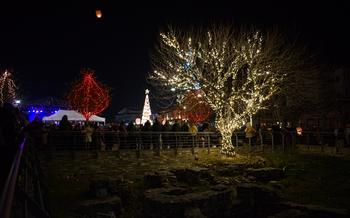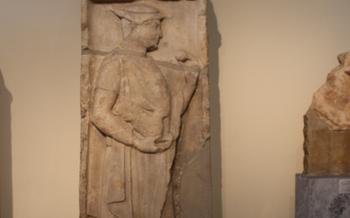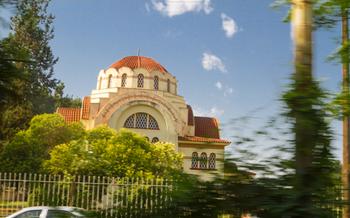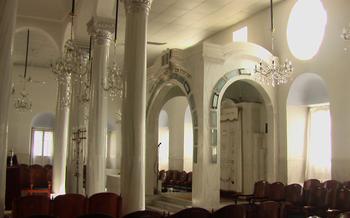
Monastery of St. John the Baptist
- The Monastery of St. John the Baptist: A Haven of History and Spirituality
- Unveiling the Ancient Mosaics: A Journey Through Time
- Exploring the Church of St. John the Baptist: A Sacred Space
- The Stunning Views from the Monastery: A Panoramic Delight
- The Village of Ampelonas: A Charming Hamlet Nearby
- The Annual Festival of St. John the Baptist: A Celebration of Faith
- The Theological School of Larissa: A Center of Learning
- The Surrounding Landscape: A Natural Paradise
- Thessalian Cuisine: A Culinary Delight
- Family Recipes and Culinary Workshops
- Thessalian Wineries: A Toast to Tradition
- Thessalian Crafts: A Showcase of Local Artisanship
The Monastery of St. John the Baptist: A Haven of History and Spirituality
Nestled amidst the serene landscapes of Larissa, the Monastery of St. John the Baptist stands as a testament to the region's rich history and spiritual traditions. Its ancient origins can be traced back to the 11th century, when it was founded by a group of devout monks seeking refuge and a place of worship. Over the centuries, the monastery has undergone several renovations and expansions, reflecting the changing times and the evolving needs of the religious community.
The monastery's architecture showcases the Byzantine style, characterized by its intricate brickwork, arched doorways, and elegant frescoes. The interior of the church is adorned with stunning frescoes depicting biblical scenes and the lives of saints, creating a vibrant and awe-inspiring atmosphere. Visitors can immerse themselves in the spiritual ambiance, light a candle, or simply sit in quiet contemplation, connecting with the monastery's deep-rooted religious traditions.
Beyond its religious significance, the Monastery of St. John the Baptist has played a pivotal role in shaping the cultural identity of Larissa. It has served as a center of learning, a refuge for those in need, and a place where local traditions and customs have been preserved and celebrated. The monastery's ongoing presence and influence have left an indelible mark on the cultural fabric of the region, making it a cherished landmark and a source of pride for the people of Larissa.
Unveiling the Ancient Mosaics: A Journey Through Time
Beneath the sacred grounds of the Monastery of St. John the Baptist lies a hidden treasure—a collection of ancient mosaics that transport visitors back in time. These remarkable works of art were accidentally discovered during excavation work in the 19th century, revealing a glimpse into the rich cultural heritage of Larissa.
The mosaics, meticulously crafted with vibrant colors and intricate designs, depict scenes from Greek mythology, biblical stories, and everyday life. Each tile tells a story, inviting visitors to embark on a visual journey through history. The well-preserved condition of the mosaics is a testament to the skill and artistry of the ancient craftsmen who created them.
Beyond their aesthetic beauty, these mosaics hold immense historical significance. They provide valuable insights into the artistic styles, techniques, and iconography of the ancient Greeks. Scholars have studied the mosaics extensively, shedding light on the religious beliefs, social customs, and daily lives of the people who once inhabited this region.
The symbolism and hidden meanings embedded within the mosaic scenes add another layer of intrigue. Visitors can explore the deeper messages and narratives conveyed through the intricate details and allegorical representations. Each mosaic tells a unique tale, inviting viewers to interpret and connect with the past.
Unveiling the ancient mosaics of the Monastery of St. John the Baptist is a journey through time, a chance to witness the enduring legacy of ancient Greek art and culture. These stunning masterpieces offer a glimpse into the minds and hearts of the people who lived centuries ago, enriching our understanding of the region's rich history.
Exploring the Church of St. John the Baptist: A Sacred Space
Nestled within the monastery complex, the Church of St. John the Baptist stands as a testament to the rich religious heritage of Larissa. Adorned with intricate architectural features, the church invites visitors to immerse themselves in its sacred atmosphere.
The narthex, an entrance hall, greets visitors with its stunning frescoes depicting scenes from the life of St. John the Baptist. These vibrant paintings offer a glimpse into the deep devotion and artistry that went into the creation of this sacred space.
Stepping into the main sanctuary, one is awestruck by the beautifully preserved frescoes that adorn the walls and ceiling. These exquisite works of art portray biblical stories, religious figures, and intricate patterns, creating a visually captivating environment.
Among the most notable frescoes is the depiction of the Last Supper, which occupies a prominent position in the apse. The intricate details and lifelike expressions of the figures bring the biblical narrative to life, inspiring a sense of awe and reverence.
In addition to the frescoes, the church is adorned with a collection of icons, each representing a different saint or religious figure. These icons are objects of devotion for the local community and are often adorned with offerings and prayers.
The Church of St. John the Baptist is not only a place of worship but also a symbol of the deep connection between the monastery and the local community. Its unique architectural features, stunning frescoes, and religious significance make it a must-visit destination for anyone interested in exploring the spiritual and cultural heritage of Larissa.
The Stunning Views from the Monastery: A Panoramic Delight
The Monastery of St. John the Baptist is not only a spiritual haven but also a place of breathtaking beauty. Perched atop a hill, it offers panoramic vistas that will leave you in awe. From the monastery's terraces, you can feast your eyes on the Thessalian Plain, a vast expanse of fertile land dotted with villages, towns, and fields. The Pindus Mountains, with their snow-capped peaks, form a majestic backdrop to the east, while the city of Larissa, with its modern skyline, lies to the west.
As the sun rises, the sky transforms into a canvas of vibrant colors, painting the landscape with hues of gold, pink, and orange. The monastery's silhouette against this backdrop creates a picture-perfect moment. At sunset, the sky erupts in a symphony of warm colors, casting a golden glow on the surrounding countryside. The monastery's illuminated domes and spires add to the magical atmosphere, creating a scene that is both serene and awe-inspiring.
For photography enthusiasts, the monastery is a treasure trove of opportunities. The panoramic views, the architectural details, and the interplay of light and shadow provide endless subjects to capture. Whether you're a professional photographer or simply someone who enjoys taking snapshots, you'll find plenty of inspiration at the Monastery of St. John the Baptist.
Amidst the stunning scenery, you'll find tranquil spots to relax and soak in the serene atmosphere. Find a secluded corner on the monastery's terraces, spread out a blanket, and let the beauty of the surroundings wash over you. As you gaze out at the vast landscapes, you'll feel a sense of peace and tranquility that will stay with you long after you've left the monastery.
The Village of Ampelonas: A Charming Hamlet Nearby
Nestled at the foot of the monastery, the charming village of Ampelonas invites you to immerse yourself in its traditional Greek atmosphere. Wander through the narrow cobblestone streets, lined with picturesque stone houses adorned with colorful flowers. Discover local artisans and their workshops, where you can find unique handmade souvenirs to cherish. Savor delicious Greek cuisine at traditional tavernas, offering authentic flavors and warm hospitality. Participate in local cultural events, such as festivals, dances, and exhibitions, to experience the vibrant spirit of the village. Ampelonas is a true hidden gem, waiting to be explored and enjoyed.
The Annual Festival of St. John the Baptist: A Celebration of Faith
The annual festival of St. John the Baptist is a vibrant and joyous event that takes place in Larissa each year. The festival is a celebration of the saint's life and legacy and attracts thousands of pilgrims and visitors from around the region. The festivities begin with a solemn procession through the streets of Larissa, carrying the icon of St. John the Baptist. The procession is followed by a series of religious services and prayers at the monastery. Throughout the festival, there are traditional Greek music, dance, and theater performances, as well as stalls selling local delicacies and souvenirs. The festival is a wonderful opportunity to experience the rich cultural and religious traditions of Larissa and to join in the celebration of St. John the Baptist.
The Theological School of Larissa: A Center of Learning
Deeply embedded within the historical tapestry of Larissa, the Theological School of Larissa stands as a beacon of religious education and scholarship. Founded in the early 20th century, this esteemed institution has cultivated a reputation for academic excellence and spiritual guidance. The school offers a comprehensive range of theological programs, encompassing biblical studies, church history, ethics, and pastoral counseling.
Dedicated faculty members, well-versed in their respective fields, impart knowledge and wisdom to students who aspire to serve as religious leaders, scholars, and educators. The school's curriculum emphasizes both theoretical understanding and practical application, preparing students for real-world ministry and service to their communities.
Beyond the classroom, the Theological School of Larissa fosters a vibrant student life, where students engage in various academic activities, social events, and community service initiatives. This holistic approach to education nurtures not only intellectual growth but also personal and spiritual development.
The school's contributions to theological education and religious scholarship have had a profound impact on the region and beyond. Graduates of the Theological School of Larissa have gone on to serve in various capacities within the Greek Orthodox Church, as well as in academia, interfaith dialogue, and social work.
Whether you are a prospective student seeking a transformative educational experience or a visitor interested in exploring the rich theological heritage of Greece, the Theological School of Larissa welcomes you with open arms.
The Surrounding Landscape: A Natural Paradise
Thessaly is blessed with a diverse and captivating natural landscape that extends beyond the city of Larissa. Just a short drive from the Monastery of St. John the Baptist, visitors can immerse themselves in the tranquility and beauty of the surrounding countryside. Hiking enthusiasts will delight in the scenic trails that meander through lush forests and along the banks of sparkling rivers. The trails offer varying levels of difficulty, catering to both experienced hikers and those seeking a more leisurely stroll.
Nature lovers can pack a picnic and find idyllic spots to enjoy a meal surrounded by nature's splendor. The area is also a haven for bird enthusiasts, with a diverse array of bird species inhabiting the region. Keep an eye out for soaring eagles, colorful hoopoes, and melodious nightingales.
Nestled amidst the picturesque landscape are charming mountain villages, each with its unique identity and traditions. Visitors can wander through narrow cobbled streets, admire traditional stone houses, and interact with friendly locals. These villages offer a glimpse into the authentic Thessalian way of life and provide a welcome respite from the hustle and bustle of city life.
Thessalian Cuisine: A Culinary Delight
Thessaly is renowned for its rich and flavorful cuisine, a testament to the region's fertile lands and culinary traditions that have been passed down through generations. Here, you can indulge in an array of traditional dishes that showcase the freshest local ingredients and reflect the region's unique cultural heritage.
Among the must-try dishes is tyropita, a savory cheese pie made with layers of crispy filo pastry filled with a creamy feta cheese mixture. Spanakopita, another popular choice, features spinach and feta cheese wrapped in flaky filo dough. For a hearty and flavorful main course, try moussaka, a traditional Greek casserole made with layers of eggplant, potatoes, ground beef, and a creamy béchamel sauce.
Thessalian cuisine is all about simplicity and freshness. Local ingredients, such as fresh vegetables, herbs, and meats, take center stage, allowing the natural flavors to shine through. Many dishes are cooked using traditional methods, such as slow-cooking in clay pots or grilling over charcoal, which imparts a unique smoky flavor.
Family Recipes and Culinary Workshops
Family recipes hold a special place in Thessalian cuisine. Many dishes are passed down from generation to generation, with each family having its own unique variations and secrets. These recipes are often a source of pride and joy, and sharing them with others is a way of preserving and celebrating the region's culinary heritage.
For those who want to learn more about Thessalian cuisine, cooking workshops are a great way to get hands-on experience and learn from local experts. These workshops typically cover traditional dishes, such as making filo pastry, preparing cheese pies, or cooking moussaka. Participants can learn about the history and significance of the dishes, as well as the techniques and ingredients used.
Thessalian Wineries: A Toast to Tradition
Thessaly, a region renowned for its rich culinary traditions, also boasts a thriving winemaking industry. The region's long-standing tradition of viticulture dates back centuries, and the unique grape varieties grown in Thessaly contribute to the distinctive flavors of its wines.
Nestled among rolling hills and fertile valleys, Thessalian wineries offer a delightful experience for wine enthusiasts. Embark on a wine tour to visit local wineries, sample their wines, and learn about their production methods. Discover the secrets behind the region's renowned wines as you sip on a glass of crisp white or a robust red, surrounded by the picturesque scenery of Thessaly.
Wine festivals are another highlight of the Thessalian experience. These vibrant celebrations honor the region's winemaking heritage and offer a chance to savor the local wines alongside delicious food, live music, and traditional dancing. Immerse yourself in the festive atmosphere as you raise a toast to the rich flavors and traditions of Thessaly.
Thessalian Crafts: A Showcase of Local Artisanship
Thessaly is renowned for its vibrant craft traditions, which have been passed down through generations. Skilled artisans create unique handmade products using traditional techniques, preserving the region's rich cultural heritage.
In the picturesque villages of Thessaly, you'll find workshops where artisans weave intricate textiles, shape clay into beautiful pottery, and carve wood into elegant sculptures. Each craft tells a story, reflecting the region's history, traditions, and natural beauty.
Visit local craft markets to discover a treasure trove of handmade items, from delicate jewelry and colorful ceramics to intricately carved wooden objects. These markets are a great place to meet the artisans, learn about their techniques, and find unique souvenirs to cherish.
If you're tertarik to learning a traditional craft, participate in a hands-on workshop. Under the guidance of experienced artisans, you'll learn the basics of weaving, pottery, or woodcarving, creating your own unique piece to take home as a reminder of your time in Thessaly.
Immerse yourself in the vibrant world of Thessalian crafts and discover the passion and creativity of the local artisans. Whether you're shopping for souvenirs, learning a new skill, or simply admiring the beauty of traditional craftsmanship, Thessaly offers a rich and rewarding experience for all.









